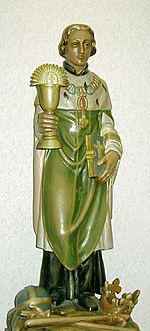Clodoald facts for kids
Quick facts for kids SaintClodoald |
|
|---|---|

Modern statue of Saint Cloud as prince in St. Cloud Hospital, Minnesota.
|
|
| Confessor | |
| Born | 522 |
| Died | c. 560 Nogent-sur-Seine, Kingdom of the Franks (now France) |
| Venerated in | Roman Catholic Church Eastern Orthodox Church |
| Major shrine | Saint-Cloud, France |
| Feast | 7 September |
| Attributes | A Benedictine abbot giving his hood to a poor man as a halo emanates from his head; with royal insignia at his feet, or instructing the poor |
| Patronage | Against carbuncles; nail makers; Diocese of Saint Cloud, Minnesota; France |
Clodoald (also known as Saint Cloud) was a prince from the Merovingian family. He was born around 522 AD. Clodoald was the grandson of the famous King Clovis I, who was a very important ruler in early French history.
Instead of becoming a king, Clodoald chose a different path. He decided to live a quiet life as a hermit and a monk. He found a peaceful hill near Paris, in a place now called Saint-Cloud. There, among fishermen and farmers, he lived a simple life of prayer. He even built a church dedicated to Martin of Tours. Today, Clodoald is honored as a saint in both the Catholic and Orthodox Churches.
Contents
Who Was Clodoald?
Clodoald was the son of Chlodomer, who was the King of Orléans. His mother was Guntheuc. Clodoald had two brothers, Theodoald and Gunther. After his father died, Clodoald and his brothers were raised in Paris by their grandmother, Clotilde, who was a queen.
A Dangerous Time for Princes
After King Clovis I passed away, his kingdom was divided among his sons. Clodoald's father, King Chlodomer, was one of these sons. Sadly, Chlodomer went to war against the Burgundians and was killed in battle in 524.
Clodoald's uncles, Childebert I (King of Paris) and Clotaire I (King of Soissons), wanted to take over their brother's kingdom. This meant they saw Clodoald and his brothers as a threat.
Clodoald's Escape
The uncles decided to kill their nephews. They tricked Queen Clotilde into sending the boys to them. According to one story, the uncles killed Clodoald's two older brothers, Theodoald and Gunther. Clodoald, however, was saved by loyal people who helped him escape. He found safety with Saint Remigius, a bishop.
Another story says the uncles considered cutting the boys' long hair. Long hair was a sign of royalty for the Franks. But their grandmother, Clotilde, said she would rather see them dead than lose their royal sign. So, the uncles killed the older boys. Luckily, Clodoald managed to get away.
Clodoald's Adult Life
After escaping, Clodoald decided he didn't want to be a king. He gave up all his claims to the throne. He chose to live a quiet life as a hermit and a student of Séverin of Paris. Séverin lived a simple, prayerful life outside Paris. Clodoald became his student and learned about religious life. He preferred a humble, peaceful life over the dangerous life of a prince.
Becoming a Monk
When Clodoald was about twenty years old, he appeared before the Bishop of Paris. The bishop cut Clodoald's long hair, which was a symbol of his royal background. His uncles, Childebert and Clotaire, saw that he was no longer a threat. They even gave him some money so he could live comfortably in his retirement.
After Séverin died, Clodoald moved away from Paris. He secretly went to a region called Provence. People there soon heard that Clodoald had a special gift for healing. He stayed there for eleven years. Then, he returned to his first hermitage near Paris, and people were very happy to see him.
Building a Monastery
In 551, people asked Clodoald to become a priest. He was ordained by Bishop Eusebius of Paris. Clodoald was known for his humility and kindness. But he didn't like being in the spotlight. So, he moved to a hill along the Seine River, a bit away from Paris. This place was called Novigentum.
There, among fishermen and farmers, he lived a life of prayer. He built a church and dedicated it to Martin of Tours. Soon, other people wanted to follow his way of life. They built small homes, and eventually, a monastery was needed. Clodoald built a monastery and a chapel using money his uncles had given him. He lived there for seven years, setting a good example for his fellow monks. He died on September 7, 560, when he was thirty-eight years old.
Why Is He a Saint?
According to stories, Clodoald knew when he would die. After his death, many miracles were said to happen near his tomb. Because of this, Clodoald was made a saint. The small village of Novigentum quickly became a popular place for pilgrims. It was renamed "Sanctus Clodoaldus" (Saint-Cloud) in his honor.
Today, his relics (parts of his body or belongings) are kept in a church in Saint-Cloud, France. Several places in the United States, like St. Cloud, Wisconsin; St. Cloud, Florida; and St. Cloud, Minnesota, are named after the French town.
Saint Clodoald's feast day is celebrated every year on September 7.
Clodoald in Art and History
- The historian Gregory of Tours wrote about Clodoald in his book History of the Franks. He mentioned how Clodoald's brothers were killed and how Clodoald chose to become a priest, giving up his royal life.
- There is a painting of Saint Clodoald by Sébastien-Melchior Cornu (1804–1870). This painting can be found in the chapel of the Elysée Palace in France.
See also
- List of Catholic saints
- Clotilde, Clodoald's grandmother
- Saint Cloud, patron saint archive
 In Spanish: Clodoaldo (príncipe) para niños
In Spanish: Clodoaldo (príncipe) para niños


